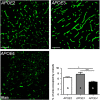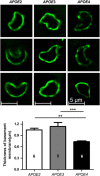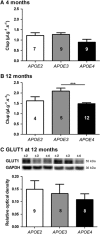Human apolipoprotein E ɛ4 expression impairs cerebral vascularization and blood-brain barrier function in mice
- PMID: 25335802
- PMCID: PMC4296574
- DOI: 10.1038/jcbfm.2014.172
Human apolipoprotein E ɛ4 expression impairs cerebral vascularization and blood-brain barrier function in mice
Abstract
Human apolipoprotein E (APOE) exists in three isoforms ɛ2, ɛ3, and ɛ4, of which APOE4 is the main genetic risk factor of Alzheimer's disease (AD). As cerebrovascular defects are associated with AD, we tested whether APOE genotype has an impact on the integrity and function of the blood-brain barrier (BBB) in human APOE-targeted replacement mice. Using the quantitative in situ brain perfusion technique, we first found lower (13.0% and 17.0%) brain transport coefficient (Clup) of [(3)H]-diazepam in APOE4 mice at 4 and 12 months, compared with APOE2 and APOE3 mice, reflecting a decrease in cerebral vascularization. Accordingly, results from immunohistofluorescence experiments revealed a structurally reduced cerebral vascularization (26% and 38%) and thinner basement membranes (30% and 35%) in 12-month-old APOE4 mice compared with APOE2 and APOE3 mice, suggesting vascular atrophy. In addition, APOE4 mice displayed a 29% reduction in [(3)H]-d-glucose transport through the BBB compared with APOE2 mice without significant changes in the expression of its transporter GLUT1 in brain capillaries. However, an increase of 41.3% of receptor for advanced glycation end products (RAGE) was found in brain capillaries of 12-month-old APOE4 mice. In conclusion, profound divergences were observed between APOE genotypes at the cerebrovascular interface, suggesting that APOE4-induced BBB anomalies may contribute to AD development.
Figures






References
-
- Eisenberg DT, Kuzawa CW, Hayes MG. Worldwide allele frequencies of the human apolipoprotein E gene: climate, local adaptations, and evolutionary history. Am J Phys Anthropol. 2010;143:100–111. - PubMed
-
- Vandal M, Alata W, Tremblay C, Rioux-Perreault C, Salem N, Jr, Calon F, et al. Reduction in DHA transport to the brain of mice expressing human APOE4 compared to APOE2. J Neurochem. 2014;129:516–526. - PubMed
Publication types
MeSH terms
Substances
LinkOut - more resources
Full Text Sources
Other Literature Sources
Research Materials
Miscellaneous

